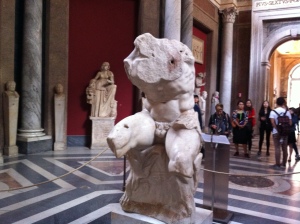BELVEDERE TORSO – Artist unknown
“The most beautiful thing we can experience is the mysterious.
It is the source of all true art and science.”
Albert Einstein
The Belvedere Torso, marble, c. 2nd century BC, Vatican Museum (picture taken with my phone May 2013)
There were many fascinating artworks when we were looking at ancient Greece and Rome, but somehow the one that made the strongest impression on me was a legless, armless and even headless fragment of a statue, The Belvedere Torso. Presently “sitting” in the Vatican, the favourite piece of the grand master Michelangelo, it served as inspiration not only to him but many other artists since its discovery in 15th century. The Torso was Michelangelo’s chief sitting model when he was painting the Sistine Chapel. On the ceiling and the wall, the Torso can be found with added limbs and a head, in Adam, in St. Bartholomew, even in the angels that line the panels on the ceiling. In fact, art historians have counted at least twenty different appearances.[1]
According to the legend, Michelangelo was asked on several occasions by Pope Julius II to restore it with prosthetic limbs, but each time Michelangelo refused saying, that it is prefect as it is. And I have to agree, because what is so attractive about the Belvedere Torso, is that so much is left to our imagination, the whole piece is shrouded in mystery. Who was the subject? Who was the sculptor? When was it made? The inscription on the base indicates a Greek sculptor Apollonius, son of Nestor, but his name is not mentioned in any of the historical records and art historians now believe that it is in fact a copy of a much older statue.
There are several theories as to who the subject is. The most prominent one is that of a sitting Hercules, based mostly on the lion skin the Torso is placed upon. But recent studies revealed that it is actually a panther skin, suggesting different explanations. Other candidates are Dionysius, Polyphemus and Marsyas among others. I personally prefer the latter, the Greek satyr who challenged Apollo to a musical competition. The hole in the lower back suggesting a tail would also support this theory. Marsyas was an expert player on the double piped instrument called Aulos and he boasted about his superior skills. There are various versions of the story, either the god challenged Marysas to a contest or Marsyas challenged the god. Apollo won and claimed the prize of the victor that they had agreed upon before beginning the contest. So Marsyas paid for his hubris by being pinned to a tree and flayed alive by Apollo, who perhaps intended to turn his skin into a wine flask.[2] In Crawford Gallery the Torso is placed right next to the Apollo Belvedere, which would place Marsyas next to his executioner.
But no matter who the subject is, the statue is an absolute masterpiece. The naked male figure with its contrapposto had a huge impact on Renaissance, where the artists return to the ideal human body and later was closely studied by Mannerism and Baroque artists; in fact it never lost its appeal to the present day. I was fortunate enough to see it just recently on our trip to Rome as you can see from my profile picture.
Michelangelo is on record saying: “This is the work of a man who knew how to do it better than nature!”[3]
[1] “The Belvedere Torso.” Rome Diary. N.p., n.d. Web. 17 Apr. 2013
[2] “Apollo And Marsyas.” About.com Ancient / Classical History. N.p., n.d. Web. 17 Apr. 2013.
[3] “The Belvedere Torso.” Rome Diary. N.p., n.d. Web. 17 Apr. 2013

One response to “First year of Art history revisited: artwork one – The Belvedere Torso”